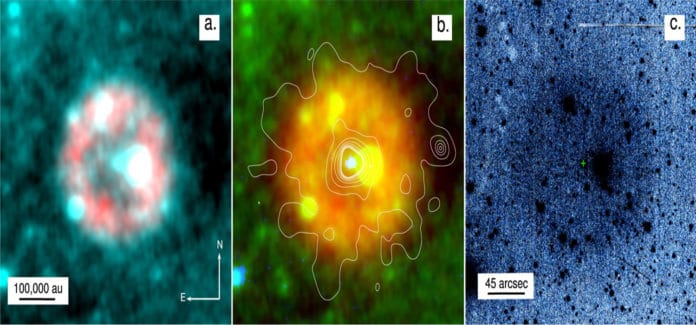The Chinese supernova, also known as the ‘Chinese Guest Star’ of 1181 AD, was originally observed by Chinese and Japanese astronomers in the 12th century. At that time, the supernova remained visible for six months.
The astronomers also recorded an approximate location in the sky of the sighting, but modern astronomers have even identified no confirmed remnant of the explosion.
Until now, the source of this 12th-century explosion remained a mystery. A new study from a team of international astronomers solved this 900-year-old cosmic mystery. Astronomers reported that a faint, fast-expanding cloud/ nebula called Pa30, surrounding Parker’s Star fits the profile, location, and age of the historic Chinese supernova of 1181AD. Parker’s Star is one of the hottest stars in the Milky Way.
Astronomers found that the Pa30 nebula is expanding at an extreme velocity of more than 1,100 km per second. Using this velocity, astronomers were able to derive an age at around 1,000 years, which would coincide with the events of 1181 AD.
Prof Zijlstra (Professor in Astrophysics at the University of Manchester) explains: “The historical reports place the guest star between two Chinese constellations, Chuanshe and Huagai. Parker’s Star fits the position well. That means both the age and location fit with the events of 1181.”
“Only around 10% of supernovae are of this type, and they are not well understood. The fact that SN1181 was faint but faded very slowly fits this type. It is the only such event where we can study both the remnant nebula and the merged Star and also have a description of the explosion itself.”
“The merging of remnant stars, white dwarfs, and neutron stars gives rise to extreme nuclear reactions and forms heavy, highly neutron-rich elements such as gold and platinum. Combining all this information, such as the age, location, event brightness, and historically recorded 185-day duration, indicates that Parker’s Star and Pa30 are the counterparts of SN 1181. This is the only Type Iax supernova where detailed studies of the remnant star and nebula are possible. It is nice to be able to solve both a historical and an astronomical mystery.”
Journal Reference:
- Andreas Ritter et al., The Remnant and Origin of the Historical Supernova 1181 AD, The Astrophysical Journal Letters (2021). DOI: 10.3847/2041-8213/ac2253
